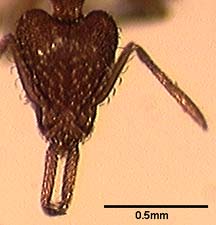Strumigenys nevermanni Brown 1959
Dacetini, Myrmicinae, Formicidae, Hymenoptera, Insecta, Arthropoda, Animalia
John T. Longino, The Evergreen State College, Olympia WA 98505
USA.
longinoj@evergreen.edu
22 April 1997

Specimen: Costa Rica, Prov. Alajuela: Rio Penas Blancas, 940m (J. Longino 4Jul84/1009). INBIOCRI001283975. Image by J. Longino.
Identification
Apical fork of mandible with one intercalary tooth; mandible with acute preapical tooth very close to apical fork, and sometimes a minute denticle near the apical third of mandible length; gaster smooth and shining, with setae stiff, straight, slightly thickened.
Head length 0.61-0.63mm, mandible length 0.36-0.38, CI 77-80, MI 58-60 (n=8 workers from 1 locality; Brown 1962).
|

Specimen: Costa Rica, Prov. Alajuela: Rio Penas Blancas, 940m (J. Longino 4Jul84/1009). INBIOCRI001283975. Image by J. Longino. line drawing of worker face (from Brown 1962) |
Similar species: micretes, JTL-003.
Brown (1959, 1962) differentiates the Mexican emeryi from the Costa Rican nevermanni by the latter lacking a preapical denticle proximal to the preapical tooth. I find this character variable in Costa Rican material.
Range
Costa Rica (mid-elevation Atlantic and Pacific slopes, Cordillera Central northward).
Natural History
Brown and Wilson (1959) summarize the genus as follows:
"Widespread in tropics and warm temperate areas. Primarily forest-dwelling; some species occur in grassland and arid scrub. ... Nests mostly in soil and rotting wood; a few species live in arboreal plant cavities in tropical rain forest. Foraging hypogaeic to epigaeic-arboreal. Food: most species are collembolan feeders; a few are polyphagous predators or occasionally feed on sugary substances..."
nevermanni occurs in wet forest habitats. It nests and forages in the low arboreal zone and in some cases in litter on the forest floor.
Selected Records
Braulio Carrillo National Park (Bajo la Hondura): This is the type locality of nevermanni, based on specimens collected by Nevermann. I also collected at this site, and found a nest in a knothole under a moss mat on a small live tree.
Guanacaste Conservation Area (Pitilla): wet forest. Under loose bark in treefall.
Penas Blancas Valley: wet forest. Nesting in small rotten knot in live shrub at edge of clearing.
Winkler samples from two sites in and near Monteverde, at 1300 and 900m on the Pacific slope.
Literature Cited
Brown, W. L., Jr. 1959. The Neotropical species of the ant genus Strumigenys Fr. Smith: Group of emeryi Mann. Entomological News 70:97-104.
Brown, W. L., Jr. 1962. The neotropical species of the ant genus Strumigenys Fr. Smith: Synopsis and keys to the species. Psyche 69:238-267.
Brown, W. L., Jr., Wilson, E. O. 1959. The evolution of the dacetine ants. Quarterly Review of Biology 34:278-294.
 Go back to top
Go back to top

